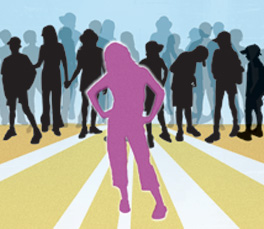Extracts

Best Protectors From Bullies? Girls Rule!
Cathy Keen
Playground bullies may meet their match from where they least expect — in the ranks of kids who are anti-bullies — and most of them are girls, a new University of Florida study finds.
“Boys may be more likely to bully, but girls are more likely to defend those being bullied,” said Jim Porter, who did the research for his doctoral dissertation in counselor education at UF. “While a lot of attention has been devoted to bully prevention programs, very little recognition is given to kids who jump in and try to stop the bullying or comfort the victim.”
These playground defenders merit attention because research shows that a majority of school shootings are committed by students who have been bullied, and victims of bullying are at risk for dropping out of school, suffering from depression and bullying others, Porter said. Thirty percent of students in sixth- through 10th-grade report some experience with bullying, either as a victim or perpetrator, he said.
Schools overlook good Samaritans as they are putting a growing number of bully prevention programs in place, in some cases relying on peer mediation where students resolve the disputes themselves, with mixed results, Porter said.
“What is missing in these programs is they don’t incorporate children who are already known to help victims,” he said. “Understanding kids who defend against bullying may reveal a new avenue toward preventing school-related violence.”
Porter surveyed 168 females and 101 males about how they believed their mother, father, best friends and favorite teachers would expect them to respond if they encountered another student being bullied. The offensive behavior included hitting, shoving, name-calling, teasing and ostracizing. Participants attended four middle schools in North Central Florida and were between the ages of 10 and 15.
Peer pressure can be a good thing, the study found. Students said teachers and parents were more likely than best friends to expect them to try to stop a bully, but they were more likely to actually intervene if the message came from a best friend. And more girls than boys reported feeling pressure from friends to come to a victim’s aid, Porter said.
Eighty-five percent of girls surveyed said their best friend would expect them to defend or help a bullying victim, compared with only 66 percent of boys, Porter said. In contrast to this 19-point percentage gap, there was only a 1- to 3-percentage point difference in expectations for boys and girls’ behavior by teachers, mothers and fathers, he said.
Being female or having more feminine traits as measured by a gender identity scale also increased the likelihood that a student would defend a bully, the survey findings showed.
“Gender stereotypes that girls are more nurturing and boys are more aggressive definitely play out in how we expect boys and girls to behave,” he said. “Somehow we communicate these expectations to kids and it can affect their behavior.”
Schools may be the ideal place to try to help change those ideas, said Porter, who is now a counselor at Alachua Integrative Medicine in Alachua. “The news sometimes suggests that violence makes schools a hazardous place to be, but schools also are where we can learn how to get along with others and become adults,” he said.
Giving a role in bully prevention programs to bystanders who step in to defend the victims on the playground and in the classroom fits in with the recent trend in educational psychology toward positive reinforcement, Porter said.
“There was a time when people were more likely to think of punishing bad behavior,” he said. “Now there is a push toward finding and rewarding good behavior.”
Porter said he has always been interested in the subject of bullying because he was often beat up as a “new kid” moving from one community to another. “I never understood but always wanted to discover why some students were able to jump in and help others,” he said.
Focusing on defenders illustrates dramatic changes in public attitudes, he said.
“There was a time when bullying was not researched because it was considered normal childhood behavior,” he said. “It was thought of as being part of growing up — this learning to determine a pecking order, and making people stronger and weeding out the weak.”
Bullying expert Drew Nesdale, a psychologist at Griffith University in Queensland, Australia, said this research suggests that a little recognized and under-used source of help might be found in the victims’ peers. “Interestingly, the fact that children who help might be responding to the expectations of others is consistent with research that has identified the powerful effect of the norms or expectations of others on their behavior.”